| Author |
Message |
    
Tech833
Moderator
Username: Tech833
Post Number: 1758
Registered: 8-2002
| | Posted on Wednesday, October 07, 2009 - 12:22 am: | 


|
Penetrator P500 EXPOSED!
By Tech 833
For close to 30 years, the Hy-Gain Penetrator model P500 and its siblings have been the benchmark for omni-directional base station antennas. According to Copper Electronics, the P500 was the best selling CB antenna of all time. It only seems right to try and discover what it is about the P500 that causes so many people to rave about it, what makes the P500 ‘tick’, and try to understand the design and engineering behind this benchmark product. At the same time, it will be an opportunity to see if the P500 lives up to its reputation, or if it is merely the recipient of a lot of positive hype.
The title of this installment might be a bit misleading since the Penetrator P500 is already ‘exposed’. Previous installments included cutting open fiberglass antennas to see what was inside the shells, therefore exposing them. Alas, the P500 is an all-aluminum antenna and there is nothing to expose, it is already naked as can be.
When testing and reviewing the fiberglass base station antennas, it was done with a lot of support from the manufacturers and the distributors since they are currently available products, and they are interested in selling them. The P500 is different since this antenna hasn’t been made or sold in over 15 years. There is no manufacturer support, which means if it is going to be done; it is going to have to be author financed in every way.
Most engineers are born curious types, and this is one antenna that has this author very curious. For years, Penetrator P500 owners have sung the praises of this mysterious antenna. Most swear up and down that nothing outperforms the Penetrator. A few say that some other antennas are as good as the Penetrator. It is rare to find someone who says that the Penetrator doesn’t live up to their standards. What makes this antenna so special? What makes it different? If it’s THAT good, why don’t they make or sell it anymore?
To find out, I asked around and found someone about an hour away who has an original Penetrator P500 not in use, and was willing to let me borrow it. A nice drive in the mountains to the California Gold Country home of “Buzzsaw”, and I had a disassembled P500 tied on to the ladder rack of my work truck, headed to the shop. Next time you hear Al (Buzzsaw) on the air, please be sure and thank him for his generous contribution to this effort.
Very little physical cleanup was required to get this loaned P500 ready for the test range. Some of the interesting traits of the Penetrator include double walled tubing for the lower section and thick, stiff tubing for ground planes and vertical pieces.
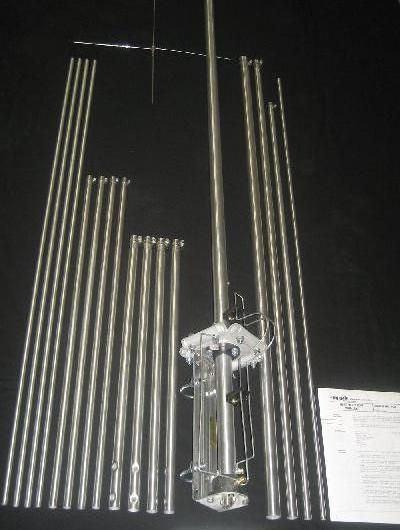
As with any 5/8 wave ground plane antenna, there must be some kind of matching network to match the 50 ohm coaxial cable to the antenna feedpoint, and phase the vertical element properly. Most 5/8 base antennas that are familiar to us use a tapped coil matching network, encased in a fiberglass or phenolic form at the base. A few use some type of exposed coil or ring matching section (the Maco V-5/8 is a modern example).
The problem with coil type matching networks is there is some loss, and there is a power limitation as higher RF current creates heat buildup in the coil and within the coil form. Also, coil phased gain antennas give up some of their gain on the horizon because the RF current swarming around the base raises the takeoff angle unless the antenna is mounted a wavelength or more above ground level.
The P500 was designed with a couple key things in mind- first of all, no coils. Second, Hy-Gain wanted to have a CB antenna that could also be sold to the hams wanting an antenna for 10 meters that will effortlessly handle full legal power (1500 watts). For this, Hy-Gain antenna company tapped into the resource of Howell Pabian, who worked for Hy-Gain for many years. Mr. Pabian had actually devised the Penetrator’s unique matching scheme over 40 years ago as a way to eliminate the coil matching scheme from gain antennas and allow air cooling for the matching network which would also increase power handling capability.
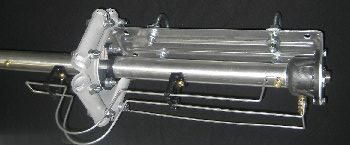
After testing, it was discovered that Mr. Pabian’s idea worked as well as planned, and through some design experimentation, it was simplified. The matching and phasing network on the Penetrator also eliminates the excess RF current around the base of the antenna, improving its ability to put signal on the horizon instead of wasting it at high angles, as I later discovered on the test range. Penetrator designer Mr. Pabian is now retired in the Lincoln, Nebraska area.
The Penetrator actually went through a few variations as it changed with the times, and they are easy to tell apart from one another. The first version had three-piece ground radials and each uses 2 bolts to hold them to the ground plane bracket. It is known as simply the “Penetrator”. The second version (sometimes called the ‘40 channel version’) released around 1981 uses only two sizes of tubing for the ground radials, and uses only 1 bolt per ground plane mounting bracket. It was known as the “Super Penetrator”. The last (newest) version was similar to version 2, but the aluminum parts were anodized to a gold color, and it is known as the “Golden Super Penetrator”. Other than physical differences, the antennas are electrically the same.
Looking at the schematic, the Penetrator P500 is completely at ground potential, which means that static will not build up on the antenna and it ends up being much ‘quieter’. In fact, when the P500 was first assembled and installed on the test tower, it was a dry, windy day and static could be heard snapping from the tophat at the upper end of the antenna. With a receiver connected to the coax, no RF static noise could be heard. Impressive.
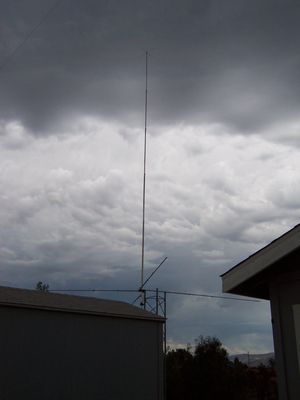
The original version Penetrator P500 I borrowed was assembled and tuned on a short test tower for 27.200 MHz. and marked. Then, the antenna was disassembled and transported to the test range for some more sophisticated scientific experiments.
Before spinning the P500 to plot the pattern, I first used a handheld RF current detector to probe around the antenna and find out where the RF hot-spots are. It was eye opening to discover that very little RF actually radiates from or around the mounting bracket and base of the antenna. Not until the probe was above the phasing section was substantial RF detected. The phase cancellation within the phasing stub is very effective. The ground planes are also very effective on the P500 with reduced RF current detected the farther away you probe from the mounting bracket and feedpoint. That will keep RF off of your feedline and out of your shack.
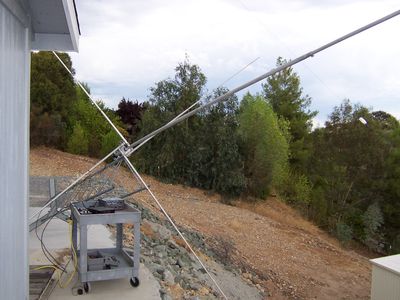
That is also an advantageous characteristic for installations where electronics that are subject to interference are located nearby. If the Penetrator is mounted high enough, the RF field over your neighbors’ houses will be greatly reduced, which will minimize the chances for RF saturation types of interference.
Measured RF current along the radiator was fairly consistent with a typical 5/8 wave radiator. Since FCC rules regarding CB antennas limit the height above a structure in some cases, the P500 uses top loading to reduce the physical length of the vertical radiator, but in this case, the tophat also evens out the current along the radiator, which should make the vertical pattern very smooth.
Once the actual testing began, there were no shocking surprises or anything unusual to report. The P500 has a very smooth, predictable 5/8 wave gain pattern. With the unique matching and phasing network, modeling shows the P500 will be less picky about mounting height above ground than a typical 5/8 wave gain antenna, although it is still recommended for ANY gain type antenna that the feedpoint be a minimum of ½ wave above ground. Field plotting and modeling show the Penetrator has a true 3 dB gain.

After playing with the on-loan P500 at the test range, I decided to take the Penetrator home and mount it on a test tower for some on-air testing. In order to really experience the Penetrator, I thought it would be best to see if it would tune up to the 10 meter amateur band. This way, I could try it on the air and also experiment with its power handling capabilities.
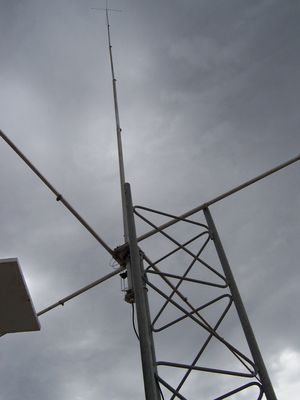
I am happy to report the Penetrator can be tuned to the 10m ham band with no cutting or adjusting of the matching or phasing network. Simply shorten the vertical radiator. This is easily accomplished since the P500 vertical pieces are assembled with tubing compression joints and clamps. As you can see in the bandwidth charts, the P500 bandwidth was reduced slightly after retuning it to the 10m ham band. However, with a slight touch-up from a tuner, it still covers the entire band without trouble.
Comparing the P500 to a ¼ wave ground plane, the performance increase is really noticeable. Signals normally in the 5 to 6 S-unit range popped up near, or in the red. For example, one 10m beacon that is about 60 miles away from me usually comes in about 7 S-units on the ¼ wave ground plane. Flip the switch to the Penetrator and the signal jumps up past 9, right into the red. This improvement was consistent with every signal I tuned in. This is not a calibrated measurement by any means, no S-meter is.
Transmitting wise, stations copying me reported the same, or better improvement of the P500 over the ¼ wave ground plane. Admittedly, this is not a very scientific test, it was just an un-technical experiment over several weeks and various conditions. Running full legal limit of 1500 watts (CW), I did not notice any warming of the materials, and nothing failed, even during prolonged QSOs.
I also discovered just how quiet the P500 is. During some tests, noise on the 10m band on both the longwire and the ¼ wave ground plane antennas was running at approximately 1 S-unit. Switching to the P500, the noise would drop to zero, but actual signals increased! This is an expected characteristic of an antenna with a higher Q, and therefore, a narrower bandwidth. This really cuts broadband noise.
With such tremendous performance, it’s easy to why people rave about this antenna and why there is still a demand for this antenna. So, why isn’t the Penetrator still available new? Some research turned up some possible answers.
In the 1980’s, the federal government released new laws pertaining to the marketing and sale of CB antennas. In response to a lot of deaths reportedly due to installers fatally shocked by CB antennas falling across power lines, the government created law stating that CB antennas must insulate the installer at potentials up to 14,500 volts. That is about the time you started seeing fiberglass antennas like the Shakespeare Big Stick and the Antron 99 appear. The heyday of the all-aluminum CB antenna was over, and with that, the Penetrator P500 was discontinued.
Not long after, the Hy-Gain company sold their name, patents, tooling, and rights to a company called MFJ, well known for their amateur radio accessories. MFJ also owns the Cushcraft antenna company in addition to making their own line of MFJ brand amateur antennas. MFJ representatives told me that they still offer some of the parts for Hy-Gain antennas that are compatible with their older CB line, but they have no intention of offering the CB antennas for sale again. Issues of liability are the reported cause for this policy.
In the future, I plan to compare the P500 to an Antron 99 and an Imax 2000. I believe that would be an interesting experiment. However, it is time to return this Penetrator to its long-time owner. One final careful disassembly, and bundle all the pieces together for transport.
Since the Penetrator P500 isn’t currently in production, and the current owner of all the Hy-Gain designs and patents has no plans to reintroduce the product, the only hope for obtaining a Penetrator is to find one used. Luckily, thousands were sold over the years, and with market saturation like that, there are still plenty of them to be found.
In fact, that is exactly what I did recently, and it will be the subject of the next installment- Restoring a used Penetrator P500 antenna. Stand by for a really exciting project involving saving a damaged Penetrator antenna that was literally found in a trash pile, waiting to be hauled to the dump, and lovingly rebuilding it to ‘better-than-new’ condition and seeing it perform just like it did in 1975.
This story is FAR from over!
-Tech 833
Acknowledgements:
Thanks to Jim Dent for his guidance, photos, files, and information.
Thanks to Evan Haydon (formerly of Hy-Gain) for his research.

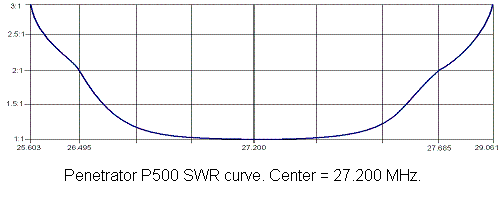
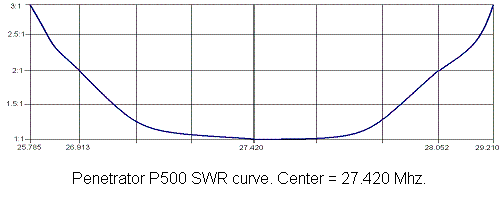
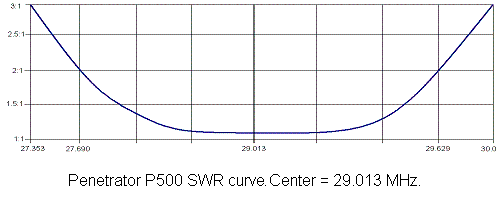 |
    
Starface
Senior Member
Username: Starface
Post Number: 2607
Registered: 1-2005

| | Posted on Sunday, October 18, 2009 - 7:55 am: | 


|
Thanks Paul, Great Article, I await to read more.
George/Starface/KI4NBE
CEF 476 CVC 014 HAM 181
SOUTHEAST CEF NET CONTROL
|
    
Dale
Senior Member
Username: Dale
Post Number: 1503
Registered: 12-2002
| | Posted on Monday, October 19, 2009 - 11:31 am: | 


|
great atricle.im also curious how it would compare to the imax2k also the maco 5/8
dale/a.k.a.hotrod
cef426
cvc#64
|
    
Casey
New member
Username: Casey
Post Number: 8
Registered: 11-2010
| | Posted on Friday, May 20, 2011 - 9:18 pm: | 


|
This excellent article about an old friend since 1974 needs to be kept alive.
I believe the Penetrator is actually a .64.
I believe they called it a 5/8 because .64 is so close to .625 and because all top antennas were 5/8 back in the day, so why call it anything other than what was selling at the time?
Mine measures 274" of radiator for zero reactance and 1:1 swr on 27.385. If you add the average circumference of the radiator (.65 Pi = 2") to the 274" radiator you get 276"
.64 of a full wave at 27.385 is 276"
.625 of a full wave a 27.385 is 269.5"
I get just about an s unit improvement over my Imax and about 2 s units more than my MACO V5/8.
I saw about 1/2 s unit more than my I-10K until I extended the I10K to .64, then they were neck and neck at 75 miles.
Rumor has it production of the Penetrator by MFJ will begin around July 2011, however, I believe it will be sold as a 10m / 12m Amateur radio antenna. |
    
Road_kill_radio
New member
Username: Road_kill_radio
Post Number: 2
Registered: 7-2011
| | Posted on Thursday, August 25, 2011 - 7:26 am: | 


|
Now that the (S)P500 is back in production, why not do that follow-up review you promised and compare it to the Imax, A99 and an early P500?
Now THAT I'd like to read!
You might even do some youtube RadioGates showing the differences in performance, and especially if the radio has a nice big bright analog meter like the one in the Johnson Messenger 223. |
    
Tech833
Moderator
Username: Tech833
Post Number: 2033
Registered: 8-2002
| | Posted on Friday, August 26, 2011 - 10:20 am: | 


|
Would you be willing to donate a new P500 antenna for the followup?
73,
833
Your radio 'Mythbuster' since 1998
|
    
Road_kill_radio
New member
Username: Road_kill_radio
Post Number: 4
Registered: 7-2011
| | Posted on Thursday, September 15, 2011 - 5:09 am: | 


|
No problem on donating a new P500 if you will ship it back when finished.
In what state do you reside?
73 |
    
Bassbug
Member
Username: Bassbug
Post Number: 65
Registered: 7-2002

| | Posted on Friday, September 16, 2011 - 12:33 am: | 


|
Thanks! Tech 833. I enjoyed the article “The Pentrator Exposed” I know of a location of a antenna that is exactly like the Pentrator. The only difference is this antenna is light blue in color. With one of the three ground plain elements missing. Dint Shakespeare paint there antennas light blue in the 70's as part of there antenna trade mark? This light blue coating has keep the antenna in “like new” condition. This antenna is on the roof of a old restaurant business, that has been located in this spot for many years. |
    
Tech833
Moderator
Username: Tech833
Post Number: 2046
Registered: 8-2002
| | Posted on Friday, September 16, 2011 - 10:27 am: | 


|
CA and NV.
Be advised- It could take a few months. Business comes before pleasure. Also, no guarantee there wouldn't possibly be damage or loss.
73,
Your radio 'Mythbuster' since 1998
|
    
Bassbug
Member
Username: Bassbug
Post Number: 66
Registered: 7-2002

| | Posted on Friday, September 16, 2011 - 12:58 am: | 


|
I went to QRZ.com and found:
W0QAN
FCC Extra Class Ham ticket.
Howell D Pabian
300 Sycamore Dr
Lincoln, NE 68510
USA |
    
Dale
Senior Member
Username: Dale
Post Number: 1877
Registered: 12-2002
| | Posted on Sunday, August 19, 2012 - 2:15 pm: | 


|
i also seen the new p-500 is now advailable.
how about some copper fourm members getting one and replacing thier current antenna and do a review. id bet you,d see alot less imax/a99 antennas...lol
dale/a.k.a.hotrod
cef426
cvc#64
454 [dx numbers]
38lsb
|
    
Cdn_superpower
Member
Username: Cdn_superpower
Post Number: 78
Registered: 6-2005

| | Posted on Sunday, November 03, 2019 - 12:48 pm: | 


|
Any update on the new SPT500?
I'm interested in buying one.
Is it as good as the original?
Can it handle 1500W?
Will it last 20 years in the air like the original? |
    
Dale
Senior Member
Username: Dale
Post Number: 2369
Registered: 12-2002
| | Posted on Friday, November 08, 2019 - 8:14 am: | 


|
i know couple people that use them locally.. they seem to work well.yes there still rated at 1500 watts.to my best of knowledge they appear to be the same as the old ones
dale/a.k.a.hotrod
cef426
cvc#64
454 [dx numbers]
38lsb
|
    
Centurion
Junior Member
Username: Centurion
Post Number: 11
Registered: 7-2020
| | Posted on Saturday, November 07, 2020 - 10:07 am: | 


|
I have a 4 radial super penetrator i have used this antenna since the early 80s it was built in the 70s I got it from a ham operator and it was missing the radials i replaced them and tuned for 11 meter almost a perfect match on any radio and if used with a tuner you can get a flat SWR! i run a RCI 2950 on it at present it still works great for an old dog!! |
|



